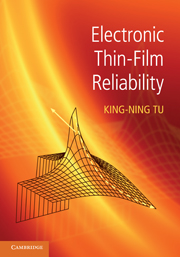Book contents
- Frontmatter
- Dedication
- Contents
- Preface
- 1 Thin-film applications to microelectronic technology
- 2 Thin-film deposition
- 3 Surface energies
- 4 Atomic diffusion in solids
- 5 Applications of the diffusion equation
- 6 Elastic stress and strain in thin films
- 7 Surface kinetic processes on thin films
- 8 Interdiffusion and reaction in thin films
- 9 Grain-boundary diffusion
- 10 Irreversible processes in interconnect and packaging technology
- 11 Electromigration in metals
- 12 Electromigration-induced failure in Al and Cu interconnects
- 13 Thermomigration
- 14 Stress migration in thin films
- 15 Reliability science and analysis
- Appendix A A brief review of thermodynamic functions
- Appendix B Defect concentration in solids
- Appendix C Derivation of Huntington's electron wind force
- Appendix D Elastic constants tables and conversions
- Appendix E Terrace size distribution in Si MBE
- Appendix F Interdiffusion coefficient
- Appendix G Tables of physical properties
- Index
- References
15 - Reliability science and analysis
Published online by Cambridge University Press: 05 July 2014
- Frontmatter
- Dedication
- Contents
- Preface
- 1 Thin-film applications to microelectronic technology
- 2 Thin-film deposition
- 3 Surface energies
- 4 Atomic diffusion in solids
- 5 Applications of the diffusion equation
- 6 Elastic stress and strain in thin films
- 7 Surface kinetic processes on thin films
- 8 Interdiffusion and reaction in thin films
- 9 Grain-boundary diffusion
- 10 Irreversible processes in interconnect and packaging technology
- 11 Electromigration in metals
- 12 Electromigration-induced failure in Al and Cu interconnects
- 13 Thermomigration
- 14 Stress migration in thin films
- 15 Reliability science and analysis
- Appendix A A brief review of thermodynamic functions
- Appendix B Defect concentration in solids
- Appendix C Derivation of Huntington's electron wind force
- Appendix D Elastic constants tables and conversions
- Appendix E Terrace size distribution in Si MBE
- Appendix F Interdiffusion coefficient
- Appendix G Tables of physical properties
- Index
- References
Summary
Introduction
We should define what reliability science is. When a device is manufactured to provide a unique function in applications, it is generally expected that the microstructure in the device will be unchanged in its lifetime of use. Unfortunately, this is not true. In electronic device applications, we have to apply an electric field or current. Under a high-current density, electromigration induces changes in microstructure and leads to circuit failure due to opening by void formation or shorting by whisker extrusion. The high-current density also causes joule heating and the temperature rise will lead to thermal stress between different materials having a different thermal expansion coefficient in the device. The stress and temperature gradients will induce atomic diffusion, phase change, and microstructure instability. What is unique in these microstructure changes is that they occur in the domain of non-equilibrium thermodynamics or they are irreversible processes. The basic science to provide an understanding of phase changes in irreversible processes that leads to device failure is reliability science. From the point of view of applications, physical and statistical analyses on the basis of reliability science should be able to predict the lifetime of a device [1–4].
The traditional metallurgical phase changes occur between two equilibrium states, and they are defined under constant temperature and constant pressure, for example the phase change in a piece of solder of eutectic SnPb going from 200°C to 100°C at ambient pressure.
- Type
- Chapter
- Information
- Electronic Thin-Film Reliability , pp. 336 - 362Publisher: Cambridge University PressPrint publication year: 2010



